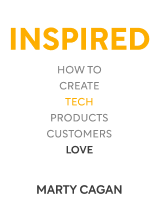

This article is an excerpt from the Shortform book guide to "Inspired" by Marty Cagan. Shortform has the world's best summaries and analyses of books you should be reading.
Like this article? Sign up for a free trial here .
How can you organize and structure an effective team? What are the three key roles in a product development team?
In the book Inspired, Marty Cagan says that there are five key steps to structuring a product development team. Additionally, there are three key roles plus supporting players who all come together to create an effective team.
Here’s how to go about creating your development team.
Creating Effective Teams
Marty Cagan’s Inspired gives companies and entrepreneurs a two-step plan for creating and sustaining successful technology products:
- Organize and structure effective teams.
- Develop products using a flexible “discovery process.”
This article will focus on the first step.
Inspired also explains how important product managers are in product development, teaches them how to be successful, and explains some of the biggest pitfalls that most tech companies fall into when designing products.
Author Marty Cagan, a Silicon Valley product executive, also details how product designers and engineers should function in a team and how company executives should treat their product teams. Originally published in 2008, the book was updated in 2018 to further address evolving concepts such as lean and agile techniques.
Team Building
In Inspired, Marty Cagan says that before companies can develop new products, they must first organize and structure their product teams for success. Key structuring steps are to:
- Maintain a relatively flat reporting structure. While some engineers may report to a more senior engineer or some UX (user experience) designers may report to a more senior UX designer, no one reports directly and only to the product manager. A flat structure helps team members feel they have a say in the direction of the team and that they’re not just following orders from above.
- Have team members sit next to one another and see each other’s screens when possible to better encourage collaboration and problem-solving.
- Make teams responsible for only part of a larger product, especially at big tech companies. This helps teams feel they “own” at least part of the product rather than being a cog in the machine, and it helps teams know where their work begins and where it ends.
- Keep teams together over multiple projects so they can better understand each other’s work styles, strengths, and weaknesses. If most team members are missionaries who are passionate about the mission of the team and company, this is easier, because they’ll be less likely to leave the company.
- Give teams autonomy over their projects so they feel more invested in them. With greater autonomy, they’ll also have to take responsibility for understanding how their product functions.
Product Manager
A successful product development team has three key roles—a product manager, designer, and engineers—plus supporting players including marketers and analysts. The most critical role is the product manager, who must understand what ideas will succeed and what ideas will fail. A product manager is knowledgeable about:
- Customers: The product manager understands who the desired customers for a product are and what they want or need. This includes a qualitative understanding of the customer—or why customers buy—and a quantitative understanding of the customer—or exactly what they buy and at what rates.
- Data: A product manager knows how to use analytics to make good decisions. This contributes to the quantitative understanding of the customer—if a product manager understands sales and usage data, she’ll understand customer behavior better.
- The company: A product manager knows what’s going on at all levels of the company and who makes decisions. She understands the sales department and the marketing departments, but also knows the CEO and what his interests are. Understanding who the stakeholders are in each part of the company helps the product manager make decisions.
- The industry: A product manager also knows the competitors and the landscape of the industry. Is it growing, which would suggest more potential competitors, or contracting, which might make it harder to make sales? In addition to knowing what competitors are doing, the product manager also has insight into changes in technology and how social media relates to the market.
Product Designer
The second key team member is the product designer or UX designer, who is responsible for designing the product with the customer and user experience in mind. Product designers ask some of the following questions when designing a product:
- Where will customers hear about the product?
- How will users interact with one another?
- What other, competing products can get in the way of the customer choosing, and subsequently using, ours?
- How will users’ experience change as they continue to use the product over time?
- What will users enjoy about the product?
- What will users find unique about the product?
- What will users tell their friends about the product?
While product managers have a holistic understanding of how the product functions, product designers may better understand how the product’s target audience will use it, given that they are primarily concerned with user experience. This means that they are strategic partners with the product manager, and they help the product manager make decisions about all user-related questions, such as where to place a home button or whether to develop new charging technology.
The product designer can answer the questions by working with the rest of the team to develop prototypes of the product and to test them. We’ll discuss the development and testing of prototypes when we discuss product discovery.
Engineers
The third key part of the team is the engineers. Engineers are responsible for the coding and any other building that is necessary to create the product. While there is one product manager per team and generally one product designer, there are usually between two and 10 engineers per team.
Engineers are useful beyond pure coding, though. Because they’re intimately familiar with the way the code and machinery work, they often have the best understanding of how to expand the product (and the limitations on doing so).
Engineers and the product manager need a good relationship so they can share ideas and solutions. This will benefit the team because engineers are often knowledgeable about the inner workings of the product in a way that product managers are not, and so they can often contribute unique ideas about how to build products.
It’s largely up to the product manager to build this relationship. Every day, product managers solicit engineers’ ideas, and engineers ask product managers for clarification on the goals of the product. By being knowledgeable but also soliciting feedback, product managers can turn engineers into true missionaries, or product advocates.
Other Roles
In addition to the three key players, product teams, especially at bigger companies, have other supporting members, including marketing professionals, researchers, analysts, or engineers who test products.

———End of Preview———
Like what you just read? Read the rest of the world's best book summary and analysis of Marty Cagan's "Inspired" at Shortform .
Here's what you'll find in our full Inspired summary :
- A two-step plan for creating and sustaining successful technology products
- Why product managers are so important in product development
- How to avoid some of the biggest pitfalls that most tech companies fall into






